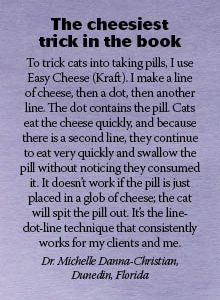Rein in pain
On a scale from 1-10, these pain management hacks are an 11.
Hey, how'd you get that hack?
We asked you! No, really-in a survey, dvm360 Clinical Updates: Practice Hacks. Over a hundred veterinarians, practice managers and team members chimed in with ways to make life easier for you, your patients and your clients, which we've organized into categories (get the full list here). It's a hack jackpot (a hackpot?)! But we didn't stop there-we've also spliced in a number of Idea Exchanges from one of Vetted's parent pubs, Veterinary Medicine.
Communicating pain: Choose the right words
•Many clients say their pet isn't in pain. “Pain” is a hot-button word. If I say “discomfort,” people seem to be more accepting of pain control.
•Make sure clients understand there's a difference between “getting old and slowing down” and pain.
•I try to compare common injuries to human disorders. For instance, ACL tears are common in athletes. I mention all of the injections, medications, therapies and surgeries that professional athletes go through to get back into playing shape. We don't have such high expectations for most pets, but they still need some sort of pain relief for good quality of life.
Communicating pain: Tell them what you'd do
•I tell clients what I use for my own dog and why I'm using these products.
•I describe my own chronic back pain and how it's treated.

Communicating pain: Ask how they'd feel
•Since I practice in a retirement community, most of my clients can relate to pain. I confirm that they don't want to hurt, so neither should they want their pet to hurt.
•Clients always say, “But they don't cry or whine!” I always ask the client if they have any aches and pains, and they will say, “My knees, my back, my neck…” And I say, “Did you walk in the door complaining about it?” When they say no, I explain it's the same with our pets. They don't have to cry out all day long to prove they're painful. They're stronger and tougher than we are, and they don't complain and beg for attention on social media like we do!
•I ask clients if they'd like to squat down to pee or poop if their knees or hips hurt.
Communicating pain: Use the evidence
•We use statistics from various studies to drive home how prevalent arthritis is in senior cats.
•I point out that pain management not only makes the pet feel better, but it can have therapeutic benefits as well (for example, slowing down the destructive aspects of inflammation).
•I ask the client what their pet loves to do and whether or not the pet can still do or enjoy their beloved activity.
•We educate clients to monitor their pets' behavior. Any changes in the pet's daily routine may signal that the pet is in pain, so we tell clients to let us know when changes arise so we can provide counsel on whether or not they are a sign of pain.
Communicating pain: Talk money
•Some concern is financial. I educate them about the supplements I recommend, but I don't give clients a hard time if they buy them from Costco.
Communicating pain: Write it down
•We provide lots of written information about pain to our clients. We write it ourselves so the information is according to our guidelines and current knowledge. We update it every time we find something new.
•Our handout helps compare the effectiveness of different pain treatments.
•We offer clients a handout in our clinic or on our website with signs of pain and common myths about pain control.
•Editors' tip: Download a client handout about recognizing pain in pets and one on signs of osteoarthritis in senior cats.

Communicating pain: Show them where it hurts
•My skeleton model helps me explain the mechanics of osteoarthritis.
•We show mouth models and explain nerve blocks for dental/oral surgery.
•We show clients radiographs and then thoroughly explain-in understandable language-what those radiographs show.
•Veterinarypartner.com has been helpful, as are before-and-after photographs.
Trial and error: Let the drugs do the talking
•We recommend a two-week trial of medications. Once pet owners see the difference, they are more willing to pay for medication. If they don't see a difference, discontinuation sometimes makes the behavior changes and symptoms more obvious to the clients.
•If a client denies that a cat is in chronic pain, I bet them a week's analgesia. If the cat feels fine, they won't see any change. No one has asked for credit on the analgesics yet.
Tools for the entire team
•We've posted Colorado State University's acute pain scales for cats and dogs in all our exam rooms and treatment areas. They help veterinary technicians keep track of how improved or degraded a patient has become over time. It also empowers clients to help with monitoring as they use the scale when looking at their pet over time.
•We use a pain questionnaire during every exam as well as a scoring system that describes key postures and behaviors associated with each level of pain for hospital patients.
•We have weight charts to facilitate quick medication dosing.
•Team members ask to take blood for Lyme tests and kidney tests should any medications need to be Rx.
•All our veterinary technicians know that pain is not permitted. They've been instructed to alert the veterinarian if any pain is perceived and are rewarded for recognizing pain.
•We use a shortcut on AVImark that adds detailed information about what was discussed during the exam at the bottom of the client's invoice: weight loss, physical therapy, NSAIDs, K-Laser therapy, omega-3, etc.
•Editors' tip: Download this team handout with steps for making your practice more comfortable for pets in pain.
Home hacks: Soft landings for painful joints
•Memory foam, bean bag and egg crate foam beds (Editors' tip: You could also recommend the Comfort Deluxe dog bed)
•Heating pads (place in windowsill for cats)

Home hacks: Get a grip on hard floors
•Baby socks with gripping pads
•We trim fur between pets' toes.
•Floor coverings, such as rugs, artificial grass, yoga mats and carpet scraps (Editors' tip: Check out this Wellness PetMat and these Power Paws socks)
Home hacks: Crafty contraptions
•Slings made out of blankets, towels or grocery sacks
•Ramps or steps up to beds and windowsills (for cats)
•Raised food and water dishes
•Litter boxes with lower sides
Don't touch this: Learn from our mistake
•Offering a swimming pool to older patients with painful joints seems like a good idea, right? We put one in at our veterinary hospital, but it was used by a grand total of one client. All other clients were unwilling to wait for their dogs to dry or cover their car interiors.